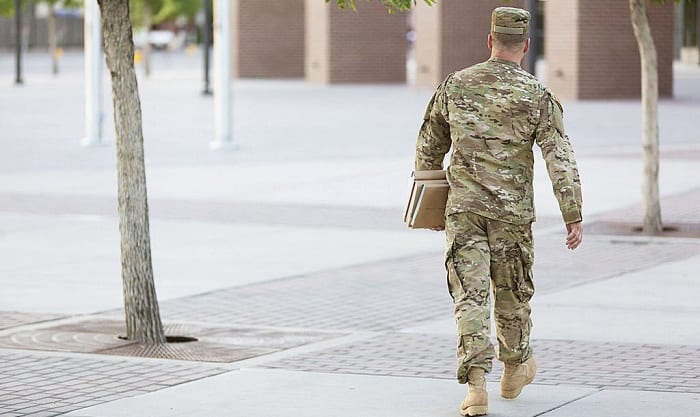In the military, when a service member fails to report to duty, they are seen as leaving military without permission under one of 3 categories: absence without leave (AWOL), desertion, and missing movement. Today’s article will explore each in detail, so keep reading to get a complete understanding!
Table of Contents
3 Categories of Leaving the Military Without Permission
1. Absence Without Leave (AWOL) (Including AWOL Meaning in Military)
This acronym stands for absence without leave, and it can be understood as a service member leaving the military without prior authorization.
In the Uniform Code of Military Justice (UCMJ), absence without leave (AWOL) is Article 86.
There are 3 cases where a member is deemed to have AWOL-ed:
- When a member is not at his or her designated duty place at the time specified
- When a member leaves his or her designated duty place
- When a member is not present at his or her duty place, unit, or organization at the time specified
An AWOL-ed member will be disciplined — the local command level and chain of command decide on the specific penalty.
Possible punishments include:
- An issued arrest, which eventually leads to a federal arrest
- Imprisonment
- 1-month confinement
- 18-month confinement
- Forfeiture of pay (2/3)
- Forfeiture of all pay
- Dishonorable discharge
In addition, there are other indirect AWOL military consequences, such as a blackened record and dimmed future prospects.
To persecute a service member of AWOL, there must be the following:
- An authority who designated a duty place and time for the service member
- A service member who knew about his or her designated duty place and time
- A service member who did not show up to his or her designated duty place and time without permission
The longer the absence prevails, the more serious an AWOL case is. Thus, a member that has been absent for 30 days will likely be penalized harder than a 3-day-absence member.
Other factors to consider to determine the seriousness of an AWOL case are what type of duty a member is absent from (i.e, special duty as a watch or guard or to avoid drills, field exercises, maneuvers, etc.) and whether the member had intentions to be absent.
The latter centers around a key question — Did the absent service member really mean to be absent or did the member intend to return? If he or she did not intend to return, it is not a case of AWOL. Instead, it is a case of desertion (which we will touch upon later).
The only potential defense for going AWOL are:
(1) The AWOL-ed service member did not know about their designated duty place and/or time
(2) The AWOL-ed service member encountered difficulties that made them unable to return
- to the designated duty place or
- to the designated duty place at the designated time
Examples include sickness and lack of transportation. But this must be supported by sufficient evidence.
Within AWOL is another status called “failure to repair.”
This is when not one member, but an entire formation is missing or has failed to show up to a designated place at the specified time.
2. Desertion
The desertion definition is outlined in the UCMJ as Article 85. There are 3 scenarios of military desertion as follows:
- When a service member is not at his or her duty place at the time he or she was ordered to
- When a service member is not with his or her unit or organization when he or she was supposed to
- And he or she has the intent to be away and not returning
- When a service member quits a duty place, unit, or organization to avoid certain tasks, services
- For example, dangerous combat, ship deployments and other duties in a combat zone
- When a service member does not officially separate but enlists in another Armed Forces
- Joining a foreign armed service without the U.S’s authorization
What happens to military deserters?
A service member guilty of desertion will be punished. Any members with an attempt to desert will also be punished.
During wartime, a service member committing desertion can be charged with the death penalty. Other countries prosecute military deserters in the same way as the US. For instance, the UK, the Soviet Union, and Canada.
You may think that this desertion is rare. After all, why join the military if you intend to abandon it, right?
But, in fact, there have been deserters throughout U.S history.
- In the 1812 War, many men in uniform committed desertion by switching units, and they did this to receive unit enlistment bonuses. The rate of desertion was roughly 12%.
- In the Mexican-American war, 8.3% deserted. There were 3 reasons why. One: to avoid the camps’ horrendous conditions. Two: for unit enlistment bonuses. Three: For free transportation to Cali – during the California Gold Rush.
- In the American Civil War, there were 200,000 Army deserters on the Union side. Deserting the Army was also not uncommon on the Confederate side. 103,400 deserted.
- In the First World War, 5,584 service members were found guilty of desertion.
- In the Second World War, over 20,000 service members were found guilty of desertion.
- In the Vietnam War, the number of deserters was estimated to be around 50,000.
Know more about what is the penalty for military desertion here.
3. Missing Movement
Missing Movement is Article 87 in the UCMJ. It refers to when a service member misses the movement of a unit, aircraft, or ship at a specific time and date even though he or she was already informed.
The service member could have missed the movement by design or because of neglect. But in either case, they can be charged with a court-martial. The only viable defense for missing movement is if the service member could not show up due to a physical inability.
- Note: But the physical inability must not be caused by misconduct or neglect.
The missing movement cases are handled by the local command, and most of the time, they are charged along with AWOL or desertion.
Other Relevant Statuses & Offenses
You may also sometimes come across the abbreviation “UA” when researching about leaving the military without permission. UA stands for unauthorized absence. It is the umbrella term for the 3 articles that have been mentioned above: absence without leave (AWOL), desertion, and missing movement.
Another status that was established in 2020 was “AUN.” This is an abbreviation for absent-unknown. This tells the military to take action and investigation to look for a missing soldier within the first 48 hrs.
Conclusion
Now that you have finished reading our article on the topic of leaving military without permission, you know that there are 3 cases: absence without leave (AWOL), desertion, and missing movement. These can be collectively referred to as unauthorized absence (UA).
Hopefully, you have got the information you were looking for from our article. If you think this can benefit someone else, please share it with them. And also, we welcome all thoughts and questions; just leave them with us in the comments below. Thank you!

I am Everett Bledsoe, taking on the responsibility of content producer for The Soldiers Project. My purpose in this project is to give honest reviews on the gear utilized and tested over time. Of course, you cannot go wrong when checking out our package of information and guide, too, as they come from reliable sources and years of experience.



